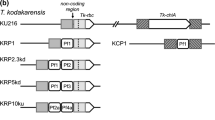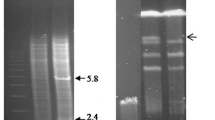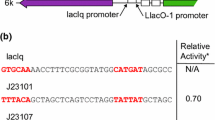Summary
We cloned sequences of the alk (alkane utilization) operon of Pseudomonas and characterized them physically and genetically. These sequences were used to construct a DNA restriction map of the alkBAC region. We physically mapped alk:: Tn7 insertions and ΔalkBA deletions, and we were able to show complementation or marker rescue of alk point mutations by cloned DNA sequences. Our results confirmed the existence of an operon containing structural loci encoding activities for membrane alkane hydroxylase component (alkB), soluble alkane hydroxylase component (alkA) and membrane alcohol dehydrogenase (alkC). Physical mapping of alkC::Tn7 insertions and complementation of alkC point mutations by cloned sequences from the alkBA region showed that we were previously mistaken in inferring the existence of a separate unlinked alkC cluster. Studies with an alkB-lacZ transcription fusion construct established that the operon is transcribed in the order alkBAC and is under positive regulation by alkR regulatory functions.
Similar content being viewed by others
References
Barth P, Grinter N (1977) Map of plasmid RP4 derived by insertion of transposon C. J Mol Biol 113:455–474
Benson S (1978) Alkane oxidation in Pseudomonas putida. PhD Thesis, University of Chicago
Benson S, Shapiro J (1975) Induction of alkane hydroxylase proteins by unoxidized alkane in Pseudomonas putida. J Bacteriol 123:759–760
Benson S, Fennewald M, Shapiro J, Huettner C (1977) Fractionation of inducible alkane hydroxylase activity in Pseudomonas putida and characterization of hydroxylase negative plasmid mutations. J Bacteriol 132:614–621
Benson S, Oppici M, Shapiro J, Fennewald M (1979) Regulation of membrane peptides by the Pseudomonas plasmid alk region. J Bacteriol 140:754–762
Birnboim HC, Doly J (1979) A rapid alkaline extraction procedure for screening recombinant plasmid DNA. Nucl Acids Res 7:1513–1521
Casadaban M, Chou MJ, Cohen S (1980) In vitro gene fusions that join an enzymaticatically active β-galactosidase segment to amino-terminal fragments of exogenous proteins: Escherichia coli plasmid vectors for the detection and cloning of translational initiation signals. J Bacteriol 143:971–980
Cohen S, Chang A, Boyer H, Helling H (1973) Construction of biologically functional bacterial plasmids in vitro. Proc Natl Acad Sci USA 70:3240–3244
Davis RW, Botstein D, Roth JR (1980) Advanced bacterial genetics: a manual for genetic engineering. Cold Spring Harbor Laboratory, Cold Spring Harbor, New York
Ditta G, Stanfield S, Corbin D, Helinski DR (1980) Broad host range DNA cloning system for Gram-negative bacteria: construction of a gene bank of Rhizobium meliloti. Proc Natl Acad Sci USA 77:7347–7371
Fennewald M, Benson S, Oppici M, Shapiro J (1979) Insertion element analysis and mapping of the Pseudomonas plasmid alk regulon. J Bacteriol 133:940–952
Fennewald M, Shapiro J (1977) Regulatory mutations of the Pseudomonas plasmid alk regulon. J Bacteriol 132:622–627
Fennewald M, Shapiro J (1979) Transposition of Tn7 in Pseudomonas aeruginosa and isolation of alk::Tn7 mutations. J Bacteriol 139: 264–269
Grund A, Shapiro J, Ennewald M, Bacha P, Leahy J, Markbeiter K, Neider M, Toepfer M (1975) Regulation of alkane oxidation in Pseudomonas putida. J Bacteriol 122:546–556
Hauer B, Shapiro J (1984) Control of Tn7 transposition. Mol Gen Genet 194:149–158
Heffron F (1983) Tn3 and its relatives. In: Shapiro J (ed) Mobile genetic elements. Academic Press, New York
Heffron F, Bedinger P, Champoux J, Falkow S (1977) Deletions affecting the transposition of an antibiotic-resistance gene. Proc Natl Acad Sci USA 74:702–706
Holmes DS, Quigley M (1981) A rapid boiling method for the preparation of bacterial plasmids. Anal Biochem 114:193–195
Long SR, Buikema WJ, Ausubel FM (1982) Cloning of Rhizobium meliloti nodulation genes by direct complementation of Nod- mutants. Nature 298:485–488
Maniatis T, Fritsch EF, Sambrook J (1982) Molecular cloning: A laboratory manual. Cold Spring Harbor Laboratory, Cold Spring Harbor, New York
Meyer R, Shapiro J (1980) Genetic organization of the broad hostrange plasmid R751. J Bacteriol 143:1362–1373
Meyer R, Laux R, Boch G, Hinds M, Bayley R, Shapiro J (1982) Broad-host-range Inc P-4 plasmid R1162: Effects of deletions and insertions on plasmid maintenance and host-range. J Bacteriol 152:140–150
McBeth D, Shapiro J (1984) Reversal by DNA amplification of an unusual mutation blocking alkane and alcohol utilisation in Pseudomonas putida. Mol Gen Genet 197:384–391
Miller J (1972) Experiments in molecular genetics. Cold Spring Harbor Laboratory, Cold Spring Harbor, New York
Mitchell D, Reznikoff W, Beckwith J (1975) Genetic fusions defining trp and lac operon regulatory elements. J Mol Biol 93:331–350
Moore RJ, Krishnapillai V (1982) Tn7 and Tn501 insertions into P. aeruginosa plasmid R91-5: Mapping of two transfer regions. J Bacteriol 149:276–283
Muster CJ, MacHattie LA, Shapiro J (1983) pλCM System: Observations on the roles of transposable elements in formation and breakdown of plasmid derived fron bacteriophage lambda replicons. J Bacteriol 153:976–990
Nieder M, Shapiro J (1975) Physiological function of the Pseudomonas putida (Pseudomonas oleovorans) alkane hydroxylase: Monoterminal oxidation of alkanes and fatty acids. J Bacteriol 122:93–98
Peterson JA, Basu D, Coon M (1966) Enzymatic ω-oxidation. I. Electron carriers in fatty acid hydrocarbon hydroxylation. J Biol Chem: 5162–5164
Schwartz RD, McCoy CJ (1973) Pseudomonas oleovorans hydroxylation-epoxydation system: additional strain improvements. Appl Microbiol 26:217–218
Shapiro J, Benson S, Fennewald M (1980) Genetics of plasmid-determined hydrocarbon oxidation. In: Stuttard C, Rozze K (eds) Plasmids and transposons: environmental effects and maintenance mechanisms. Academic Press, New York
Thomas CM, Stalker D, Guiney D, Helinski DR (1979) Essential regions for the replication and conjugal transfer of the broad host range plasmid RK2 In: Timmis KN, Puhler A (eds) Plasmids of medical, environmental and commercial importance. Elsevier North Holland, Amsterdam, pp 375–385
Ward JM, Grinsted J (1982) Physical and genetic analysis of the IncW group plasmids R388, S-a and R7K. Plasmid 7:239–250
Author information
Authors and Affiliations
Additional information
Communicated by W. Arber
Rights and permissions
About this article
Cite this article
Owen, D.J., Eggink, G., Hauer, B. et al. Physical structure, genetic content and expression of the alkBAC operon. Mol Gen Genet 197, 373–383 (1984). https://doi.org/10.1007/BF00329932
Received:
Issue Date:
DOI: https://doi.org/10.1007/BF00329932




